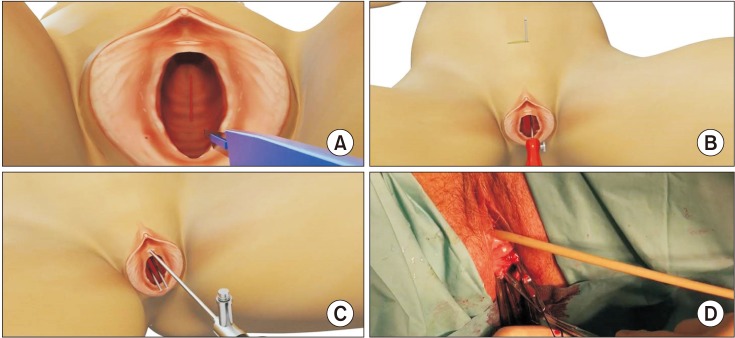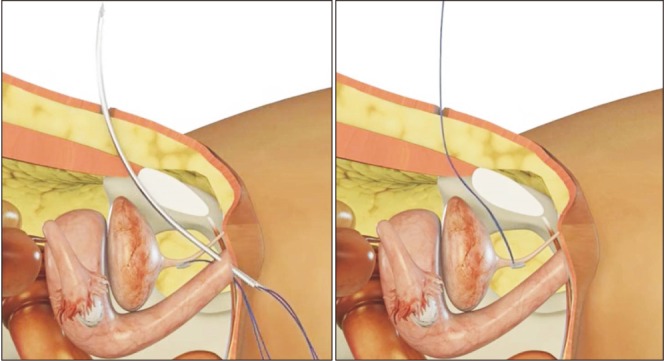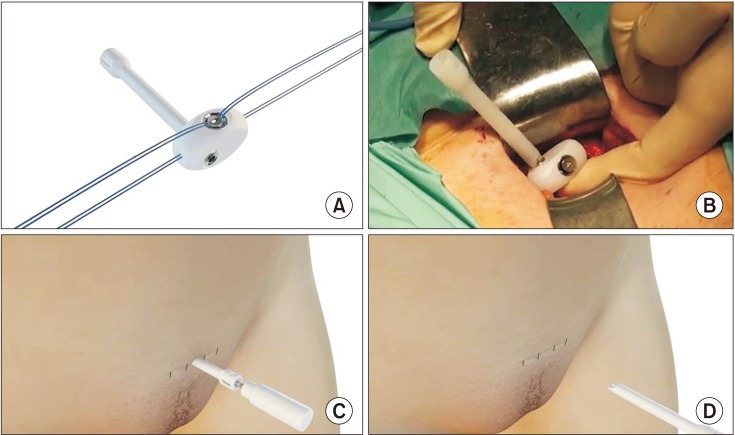Investig Clin Urol.
2019 Nov;60(6):488-495. 10.4111/icu.2019.60.6.488.
Readjustable midurethral sling (REMEEX system) in obese women
- Affiliations
-
- 1Department of Urology, Soonchunhyang University Bucheon Hospital, Soonchunhyang University College of Medicine, Bucheon, Korea. yhkuro@schmc.ac.kr
- KMID: 2461061
- DOI: http://doi.org/10.4111/icu.2019.60.6.488
Abstract
- PURPOSE
To evaluate the success rate and patient satisfaction with the readjustable midurethral sling (REMEEX system) for the treatment of stress urinary incontinence (SUI) with intrinsic sphincter deficiency (ISD) or recurrent SUI in obese and non-obese women.
MATERIALS AND METHODS
Between August 2009 and August 2015, 70 patients who treated with the REMEEX system were stratified into normal, overweight and obesity groups according to body mass index. Objective surgical outcomes were evaluated using a 1-hour pad test that was performed 3 months after surgery. The subjective outcomes and degree of patient satisfaction were evaluated 3 months and 1 year after surgery.
RESULTS
Twenty-six normal weight, 31 overweight, and 13 obese women were included in the study. The objective cure rate determined using the 1-hour pad test revealed that 11 women (42.3%) were cured and 15 (57.7%) had improved in the normal weight group, respectively, compared with 16 (51.6%) and 15 (48.4%) in the overweight group and 6 (46.2%) and 7 (53.8%) in the obese group, respectively (p=0.78). One year after surgery, the subjective success rate was 91.5% in the normal weight group, 93.5% in the overweight group and 92.3% in the obese group. A total of 84.7%, 77.4%, and 77.0% of normal weight, overweight and obese women were very satisfied or satisfied 1 year after surgery, respectively. All groups showed similar success rates and satisfaction.
CONCLUSIONS
The REMEEX procedure is equally effective in obese and normal weight women with ISD-type SUI or recurrent SUI.
Keyword
MeSH Terms
Figure
Reference
-
1. Bortolotti A, Bernardini B, Colli E, Di Benedetto P, Giocoli Nacci G, Landoni M, et al. Prevalence and risk factors for urinary incontinence in Italy. Eur Urol. 2000; 37:30–35. PMID: 10671782.
Article2. Yarnell JW, Voyle GJ, Sweetnam PM, Milbank J, Richards CJ, Stephenson TP. Factors associated with urinary incontinence in women. J Epidemiol Community Health. 1982; 36:58–63. PMID: 7069357.
Article3. Cummings JM, Rodning CB. Urinary stress incontinence among obese women: review of pathophysiology therapy. Int Urogynecol J Pelvic Floor Dysfunct. 2000; 11:41–44. PMID: 10738933.
Article4. Mommsen S, Foldspang A. Body mass index and adult female urinary incontinence. World J Urol. 1994; 12:319–322. PMID: 7881469.
Article5. Rafii A, Daraï E, Haab F, Samain E, Levardon M, Deval B. Body mass index and outcome of tension-free vaginal tape. Eur Urol. 2003; 43:288–292. PMID: 12600433.
Article6. Whitcomb EL, Subak LL. Effect of weight loss on urinary incontinence in women. Open Access J Urol. 2011; 3:123–132. PMID: 24198645.
Article7. Morgan DM, Lewicky-Gaupp C, Dunn RL, Jayaraman G, Fenner DE, Delancey JO, et al. Factors associated with urge urinary incontinence after surgery for stress urinary incontinence. Female Pelvic Med Reconstr Surg. 2011; 17:120–124. PMID: 22453782.
Article8. Sandvik H, Hunskaar S, Seim A, Hermstad R, Vanvik A, Bratt H. Validation of a severity index in female urinary incontinence and its implementation in an epidemiological survey. J Epidemiol Community Health. 1993; 47:497–499. PMID: 8120507.
Article9. Ulmsten U, Henriksson L, Johnson P, Varhos G. An ambulatory surgical procedure under local anesthesia for treatment of female urinary incontinence. Int Urogynecol J Pelvic Floor Dysfunct. 1996; 7:81–85. discussion 85–6. PMID: 8798092.
Article10. Ulmsten U, Falconer C, Johnson P, Jomaa M, Lannér L, Nilsson CG, et al. A multicenter study of tension-free vaginal tape (TVT) for surgical treatment of stress urinary incontinence. Int Urogynecol J Pelvic Floor Dysfunct. 1998; 9:210–213. PMID: 9795826.
Article11. Delorme E. [Transobturator urethral suspension: mini-invasive procedure in the treatment of stress urinary incontinence in women]. Prog Urol. 2001; 11:1306–1313. French. PMID: 11859672.12. Mellier G, Benayed B, Bretones S, Pasquier JC. Suburethral tape via the obturator route: is the TOT a simplification of the TVT? Int Urogynecol J Pelvic Floor Dysfunct. 2004; 15:227–232. PMID: 15517665.
Article13. Schierlitz L, Dwyer PL, Rosamilia A, Murray C, Thomas E, De Souza A, et al. Effectiveness of tension-free vaginal tape compared with transobturator tape in women with stress urinary incontinence and intrinsic sphincter deficiency: a randomized controlled trial. Obstet Gynecol. 2008; 112:1253–1261. PMID: 19037033.
Article14. Guerette NL, Bena JF, Davila GW. Transobturator slings for stress incontinence: using urodynamic parameters to predict outcomes. Int Urogynecol J Pelvic Floor Dysfunct. 2008; 19:97–102. PMID: 17549430.
Article15. Dmochowski RR, Blaivas JM, Gormley EA, Juma S, Karram MM, Lightner DJ, et al. Update of AUA guideline on the surgical management of female stress urinary incontinence. J Urol. 2010; 183:1906–1914. PMID: 20303102.
Article16. Thüroff JW, Abrams P, Andersson KE, Artibani W, Chapple CR, Drake MJ, et al. EAU guidelines on urinary incontinence. Eur Urol. 2011; 59:387–400. PMID: 21130559.
Article17. Lee KS, Choo MS, Doo CK, Han DH, Lee YS, Kim JY, et al. The long term (5-years) objective TVT success rate does not depend on predictive factors at multivariate analysis: a multicentre retrospective study. Eur Urol. 2008; 53:176–182. PMID: 17825478.18. Smith AL, Karp DR, Aguilar VC, Davila GW. Repeat versus primary slings in patients with intrinsic sphincter deficiency. Int Urogynecol J. 2013; 24:963–968. PMID: 23096532.
Article19. Moreno Sierra J, Marqués Queimadelos A, Araño Beltran P, De La Fuente Pérez P, Cerezuela Requena JF, Cortés Otero E, et al. [Spanish registry of the TRT Reemex system in women with stress urinary incontinence (SUI)]. Arch Esp Urol. 2006; 59:169–174. Spanish. PMID: 16649522.20. Errando C, Rodriguez-Escovar F, Gutierrez C, Baez C, Araño P, Villavicencio H. A re-adjustable sling for female recurrent stress incontinence and sphincteric deficiency: Outcomes and complications in 125 patients using the Remeex sling system. Neurourol Urodyn. 2010; 29:1429–1432. PMID: 20127837.21. Giberti C, Gallo F, Cortese P, Schenone M. The suburethral tension adjustable sling (REMEEX system) in the treatment of female urinary incontinence due to ‘true’ intrinsic sphincter deficiency: results after 5 years of mean follow-up. BJU Int. 2011; 108:1140–1144. PMID: 21554527.
Article22. Park BH, Kim JC, Kim HW, Kim YH, Choi JB, Lee DH. Midterm efficacy and complications of readjustable midurethral sling (Remeex system) in female stress urinary incontinence with recurrence or intrinsic sphincter deficiency. Urology. 2015; 85:79–84. PMID: 25530367.23. Chung JW, Yoo ES. Efficacy and safety of a readjustable midurethral sling (Remeex system) for stress urinary incontinence with female voiding dysfunction. Investig Clin Urol. 2017; 58:127–133.
Article24. Errando-Smet C, Ruiz CG, Bertrán PA, Mavrich HV. A readjustable sling for female recurrent stress incontinence and intrinsic sphincteric deficiency: long-term results in 205 patients using the Remeex sling system. Neurourol Urodyn. 2018; 37:1349–1355. PMID: 29130569.25. Mantovani F. ReMeEx device (External Mechanical Regulator) for female stress urinary incontinence: a critical review of a single-operator, long-term experience on implants and readjustments. Urologia. 2017; 84:102–105. PMID: 28315496.
Article26. Noblett KL, Jensen JK, Ostergard DR. The relationship of body mass index to intra-abdominal pressure as measured by multichannel cystometry. Int Urogynecol J Pelvic Floor Dysfunct. 1997; 8:323–326. PMID: 9609328.
Article27. Brieger G, Korda A. The effect of obesity on the outcome of successful surgery for genuine stress incontinence. Aust N Z J Obstet Gynaecol. 1992; 32:71–72. PMID: 1586341.
Article28. Dwyer PL, Lee ET, Hay DM. Obesity and urinary incontinence in women. Br J Obstet Gynaecol. 1988; 95:91–96. PMID: 3342213.
Article
- Full Text Links
- Actions
-
Cited
- CITED
-
- Close
- Share
- Similar articles
-
- Efficacy and safety of a readjustable midurethral sling (Remeex system) for stress urinary incontinence with female voiding dysfunction
- Long-term Outcome of the Readjustable Sling Procedure for Female Stress Urinary Incontinence With Intrinsic Sphincter Deficiency or Recurrence
- Assessing the Readjustable Sling Procedure (Remeex System) for Female Stress Urinary Incontinence With Detrusor Underactivity
- Impact of Body Mass Index on Postoperative Urinary Symptoms after Miduretheral Sling Surgery in Female Patients
- The Effect of Posterior Colporrhaphy Performed Concurrently with Midurethral Sling Surgery on the Sexual Function of Women with Stress Urinary Incontinence




